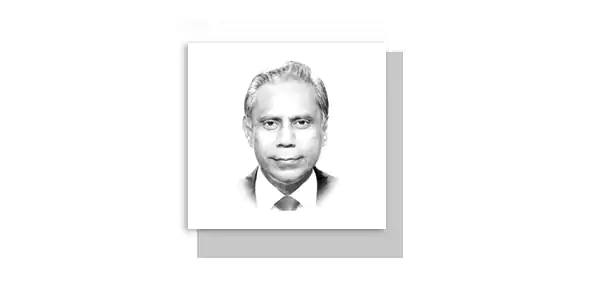THE Pakistan Air Force (PAF) shocked the world with its stunning and decisive victory against the Indian Air Force (IAF) on the night of May 6–7, 2025.
The IAF’s surprise night offensive, “Operation Sindhoor”, was not only neutralized by the PAF, but in a historic aerial duel, Pakistan’s forces downed six Indian aircraft, including three Rafale jets—long perceived as the IAF’s crown jewels.
This resounding success shattered conventional assumptions and reaffirmed the PAF’s reputation as one of Pakistan’s most elite and battle-hardened military institutions.
Much has been debated internationally, scrutinized and analysed to unravel how the PAF managed to outmanoeuvre its larger and technologically superior adversary.
The PAF’s Legacy: A History of Resilience: The answer lies in the PAF’s legacy, shaped by the visionary leadership of its founding fathers, who built a formidable force against heavy odds.
Air Marshal Asghar Khan, Pakistan’s first native Air Chief, absorbed Quaid-e-Azam’s vision of making the PAF “Second to None,” ensuring its evolution from a fledgling force in 1947—equipped with a handful of decrepit Tempests and Furies—into a modern, network-centric powerhouse.
Today, the PAF stands tall with its cutting-edge platforms, including the indigenously developed JF-17 Thunder variants, potent F-16 Block 52s, advanced AEW&C aircraft and newly inducted J-10C Vigorous Dragons.
Under the leadership of Air Chief Marshal Zaheer Ahmed Babar Sidhu, the PAF carried the baton of modernization forward, not only realizing the vision of its forebears but setting new strategic benchmarks for the future.
Evolution Through Challenges and Opportunities.
Successive PAF Chiefs played a crucial role in shaping its operational strength:
· Air Marshals Nur Khan & Rahim Khan ably led the force during the 1965 and 1971 wars, but post-war sanctions hampered modernization efforts.
· In the 1980s, during the Soviet-Afghan conflict, ACM Anwar Shamim secured the F-16 Fighting Falcons, but missed an opportunity to acquire an F-16 assembly plant, which could have mitigated the Pressler Amendment sanctions imposed in 1990.
· ACM Hakimullah’s acquisition of 90 second-hand Mirage III aircraft from Australia, Libya and Spain in 1990 under Project ROSE (Retrofit of Strike Element) was a masterstroke, securing valuable assets at a fraction of the cost.
· The pursuit of indigenous fighter development finally materialized when ACM Pervaiz Mehdi Qureshi sealed the JF-17 Thunder deal with China in 1999, further carried forward by ACM Mushaf Ali Mir.
· ACM Tanvir Mahmood saw the lifting of U.S. sanctions, enabling the acquisition of F-16 Block 52s, along with Il-78MP aerial refuelling capability, significantly extending PAF’s operational reach.
· ACM Sohail Aman championed training and exercises, ensuring operational readiness against terrorism threats while launching the Aviation City project to promote indigenous fighter aircraft development.
· ACM Mujahid Anwar Khan focused on strategic deterrence, overseeing the induction of JF-17 Thunder Block III and leading Operation Swift Retort in 2019, resulting in the downing of two IAF jets and the capture of Wing Commander Abhinandan Varthaman.
ACM Sidhu’s Masterstroke: The May 2025 Air Battle: While Operation Swift Retort in 2019 demonstrated the PAF’s prowess, it also revealed key aspects of its operational playbook.
The IAF, in response, acquired cutting-edge systems, including Rafale multirole fighters, Meteor BVR missiles, SCALP cruise missiles, Israel’s BNET software-defined radios, S-400 air defence systems, Astra BVR missiles and different versions of BrahMos missiles.
Yet, in May 2025, the PAF—under the reclusive but brilliant leadership of ACM Sidhu—turned the tide once again.
His foresight and agility ensured the rapid induction of J-10C Vigorous Dragon 4.
5++ generation fighters equipped with PL-15 BVR missiles in just 38 months—a stark contrast to the 56 months required by the IAF to operationalize its Rafale fleet.
Simultaneously, Sidhu spearheaded the deployment of HQ-9 surface-to-air missile systems and advanced unmanned aerial systems (UAS), including Wing Loong II armed drones.
These assets significantly enhanced the PAF’s intelligence, surveillance and reconnaissance (ISR) capabilities, strengthening its precision-strike and air defence potential.
Pakistan’s Triumph: Operation Bunyanun Marsoos: As mentioned earlier, on the night of May 6–7, 2025, the IAF launched Operation Sindhoor, aiming for a surprise strike against Pakistan.
The PAF, however, anticipated the incursion, intercepting and neutralizing six intruding Indian aircraft, including three Rafale jets.
In a masterfully executed precision counter-operation, codenamed Bunyanun Marsoos, the PAF demonstrated superior tactical execution and operational cohesion, effectively paralysing India’s offensive momentum and forcing it to seek a ceasefire.
The Future: A Legacy of Superiority: ACM Sidhu’s emphasis on integrating advanced technologies, expanding Cyber Command and promoting indigenous innovation has positioned the PAF as one of the world’s most technologically advanced and strategically agile Air Forces.
His leadership has ushered in a new era of multi-domain warfare, ensuring that the PAF remains a dominant force in the region.
A defining strength of the current PAF leadership lies in its strategic utilization of highly talented youth to develop the software that delivered Pakistan’s decisive cyber offensive.
The PAF’s ‘Cyber Force’ executed a coordinated digital assault, targeting Indian government institutions, infrastructure and essential services.
The attack crippled 70% of India’s electricity grid, triggering widespread power outages that plunged Northern India and Kashmir into darkness, while simultaneously disrupting ministries, railways, waterworks, airlines and other critical systems.
With each successive generation, Pakistan’s aviators, engineers and strategists will build upon this enduring foundation, ensuring the PAF’s continued evolution as a formidable force.
It will remain a vigilant guardian—deterring threats both internal and external—and upholding the nation’s sovereignty against those who seek to undermine it from within or beyond.
—The writer, Retired Group Captain of PAF, is author of several books on China. (sultanm.hali@gmail.com)


















